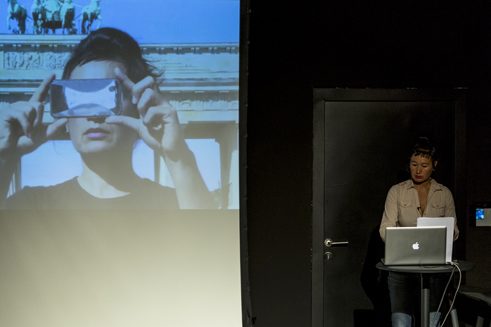Portrait
Bullet hail of images – Hito Steyerl’s enmeshed documentarisms

The artist Hito Steyerl publishes essays, works with documentary material and holds lectures. Her works are politically oriented and rebellious.
In her paper Die Farbe der Wahrheit (i.e. The Colour of Truth), published in 2008, Hito Steyerl declares doubt to be the mark of the documentary form. The authenticity of the images, as shown by the shaky smartphone photos from conflict areas and the noisy pictures of drone cameras, has little to do with clarity and knowledge. According to Steyerl, the new form of documentation is characterised by blurring, fuzziness. An artistic strategy that would continue to pursue the claim to documentation, she argues, must not dispel but rather exhibit doubt. This is the aim of Styerl’s own, mainly film-based, works.
Battlefield art
Steyerl’s Is the Museum a Battlefield, first presented at the 13th Istanbul Biennale, is a lecture into which a video work is integrated. It attempts to trace the path of combat missiles. The trail leads, ineluctably and repeatedly, to the sphere of art, for the principal sponsors of the large exhibitions and museums, as Steyerl shows, are frequently producers of weapons technology and surveillance software. The core of the work is revealed in the artist’s distinctive style: from documentary material, she deduces abstract theses, draws quasi-fictional conclusions. Thus she traces a trajectory in which the Hellfire missiles, manufactured by Lockheed Martin and launched against PKK fighters in eastern Turkey in 1998, hit a data cloud and re-materialize as “starchitecture”: the Lockheed Martin headquarters in Berlin. From the bird’s eye view, the Frank Gehry-designed building evinces the eye-catching form of a missile head. The manner of a scholarly lecture and documentary research combines with the freedom of associative thought to hit the bull’s-eye of a visual-political crisis zone.Steyerl makes visible the connecting lines between art and politics, which are always intertwined by technical conditions. Thus the video art of the 1970s gained its aesthetic freedom from exactly the same medium that simultaneously made possible the comprehensive surveillance and monitoring of society. A similarly ambivalent relation today marks the high-speed data creation and transmission by means of smartphones. They facilitate documentation of private and social events, but at the same time are the key to enhanced mechanisms of control that can completely prevent documentation by deactivating microphones and cameras of devices at a distance or using these as instruments of interception and turning them against the sender. In this way “poor images”, as Steyerl calls the low-resolution bulk of digital image production, invariably have both a subversive potential and an affinity to control and the usurpation of political freedom.
Irritation: essayism
Against this, Steyerl sets an abstraction of the documentary, one which withdraws from easily accessible interpretations. Her works are experimental arrangements inspired by visual theory, essays, now in filmic, now in written form. In her texts she experiments unconventionally with daring theses that challenge the rigid forms of scholarly discourse while simultaneously demanding to be recognised within this domain. Her essays furthermore allow themselves a free, associative and almost poetic style, far beyond the standardized language of scholarship and science.Factory of the Sun is the title of the video work that Steyerl has produced for the German Pavilion at the Venice Biennale 2015. At its core is the phenomenon of motion capture, as this is used in the film and computer game industry. It serves Steyerl as a comprehensive metaphor for a society that can record every movement. And that then relinquishes the prerogative of action to these documentations, the avatar images. Political responsibility can thus pass into the hands of a highly developed technology. Steyerl, on the contrary, embraces this responsibility in space of the museum, even in one of the best established art spaces of Europe, the Biennale. That more than economically long defused mock battles can take place here is another of her daring theses – and yet the logical beginning of a resistance in images.